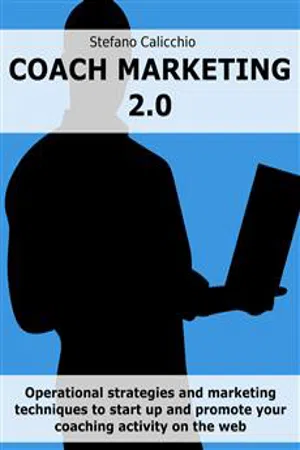
Coach marketing 2.0
Operational strategies and marketing techniques to start up and promote your coaching activity on the web
- English
- ePUB (mobile friendly)
- Available on iOS & Android
Coach marketing 2.0
Operational strategies and marketing techniques to start up and promote your coaching activity on the web
About this book
This text has been conceived as a real training course, during which numerous topics will be explored and resolved, such as - the best tools for the promotion of a coaching activity, both offline and online;
- marketing techniques dedicated to coaches;
- the consequences of the digital revolution for those involved in coaching;
- digital levers on which to act in order to acquire clients and retain them;
- the transition from traditional to digital communication;
...and much more. Professional coaches who want to start up or promote their own business cannot leave room for improvisation and need specialist skills. The coaching market is in a completely new paradigm, where on the one hand simplified access to the profession has led to increased competition and on the other hand the client is increasingly demanding. This guide explains to coaches how to find clients and set up their own marketing plan. Stop wasting time and start finding new clients now with the coach 2.0 methodology.
Frequently asked questions
- Essential is ideal for learners and professionals who enjoy exploring a wide range of subjects. Access the Essential Library with 800,000+ trusted titles and best-sellers across business, personal growth, and the humanities. Includes unlimited reading time and Standard Read Aloud voice.
- Complete: Perfect for advanced learners and researchers needing full, unrestricted access. Unlock 1.4M+ books across hundreds of subjects, including academic and specialized titles. The Complete Plan also includes advanced features like Premium Read Aloud and Research Assistant.
Please note we cannot support devices running on iOS 13 and Android 7 or earlier. Learn more about using the app.
Information
Key information to remember 1
-
Coaching has been a pioneering market in recent years, but its evolution will lead to a selection of consultants in the market, thus reaching a new stage of maturity. This implies a selection of operators currently offering their services at the level of individual coaching.
-
On the other hand, the successful coach has to solve the ambivalence created by a large and not always highly professionalised competition. On top of that, the professional is confronted with an audience of potential clients still partly unprepared for coaching.
-
Knowing and applying the new digital communication tools is a prerequisite for building a successful coaching business in such a difficult market.
-
The business plan can help coaches to clarify their career goals and to anticipate possible critical areas in the development of the profession.
Taking the field in coaching
-
contact area: all the ways in which you can be immediately reached by your customers both online and offline;
-
visibility area: i.e. the generation of possible leads or contacts through public events and market research on the Internet.
How to promote coaching with traditional tools
-
events: e.g. courses, free and/or paid workshops, award evenings, corporate or cultural events;
-
presentations: cultural, cinema-documentary, editorial, discographic;
-
advertisements: in trade magazines and publications, specialist journals, house organs and company newspapers;
-
printed advertising: flyers, leaflets, sales letters;
-
general advertising: billboards, radio spots, local and thematic TV channels.
How to promote coaching with digital tools
- a website designed for the specific activity of coaching and personal training;
- a personal blog, thanks to which you can open conversations with your readers;
- Newsletters and Social Tools.
Table of contents
- Cover
- COACH MARKETING 2.0
- Table of contents
- Introduction
- The coaching market
- Critical areas of coaching
- Possible areas of improvement
- Knowing the target market to find the customer
- Business plan
- Key information to remember 1
- Taking the field in coaching
- How to promote coaching with traditional tools
- How to promote coaching with digital tools
- Creating the coaching blog
- Newsletters and social sharing tools
- Key information to remember 2
- Moving on to advanced strategies
- How to generate value with Join Ventures
- How to get advice through ebooks
- The Bonus Factor
- The Landing Page technique + Adwords
- What to avoid: what not to do
- Taking action now: marketing plan in 3 weeks
- Key information to remember 3
- Conclusions